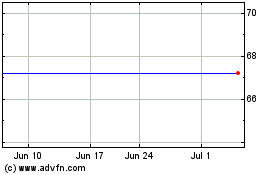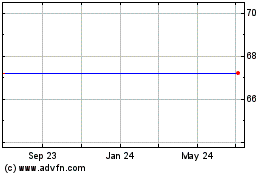Dow Chemical, Mitsui Form Brazil JV For Sugarcane Bioplastics
July 19 2011 - 3:58PM
Dow Jones News
Dow Chemical Co. (DOW) and Japan's Mitsui & Co. (MITSY,
8031.TO) said Tuesday they are starting a 50/50 joint venture to
produce plastics from Brazilian sugarcane by 2013, as Dow picks up
on a project that faltered during the global recession.
Without disclosing financial details, Dow said the endeavor
"represents the world's largest biopolymers play and is Dow's
largest investment in Brazil." Luis Cirihal, Latin America director
for renewable alternatives at Dow, said the two companies plan to
start building a sugarcane mill in the southeastern Minas Gerais
state during the third quarter, with a goal of reaching production
capacity of 240 million liters of ethanol by mid-2013.
The alcohol will then be dehydrated to ethylene gas used to
produce polymers for packaging, hygiene and medical applications,
Cirihal said.
The project builds on an earlier push by Dow to produce
sugarcane-based plastics that was derailed in 2009 amid the global
recession. That joint venture, set up in 2007 with former Brazilian
sugar and ethanol producer Santelisa Vale, reportedly had a budget
around $1 billion and was scheduled to begin production in 2011.
But the effort was suspended as Santelisa struggled to reduce its
debt burden at the height of the financial crisis.
Santelisa was soon taken over by French commodities group Louis
Dreyfus, leaving Dow with 100% control of the operation and
currently 17,000 hectares (42,007.9 acres) of sugarcane fields in
Brazil.
"We've been planting, harvesting and selling sugarcane for the
last several months," Cirihal said. He said the scope of the
project is similar to the earlier version.
Once the Dow-Mitsui mill is ready to begin crushing cane two
years from now, it will exclusively produce biopolymers, compounds
that are expected to occupy a rising share of world plastics
consumption in coming years as demand grows for environmentally
friendly products. Dow doesn't plan on producing sugar or ethanol
fuel in Brazil.
Cirihal said the Brazilian plant is aimed to be a "global-scale
facility" primarily catering to Latin American demand.
"The market is very thirsty and ready to absorb new biopolymer
capacity," he said.
-By Paul Kiernan, Dow Jones Newswires; (+55)11-3544-7074;
paul.kiernan@dowjones.com
Landaur (NYSE:LDR)
Historical Stock Chart
From Mar 2024 to Apr 2024

Landaur (NYSE:LDR)
Historical Stock Chart
From Apr 2023 to Apr 2024
